Herb Processing at the Mayway Hebei Facility
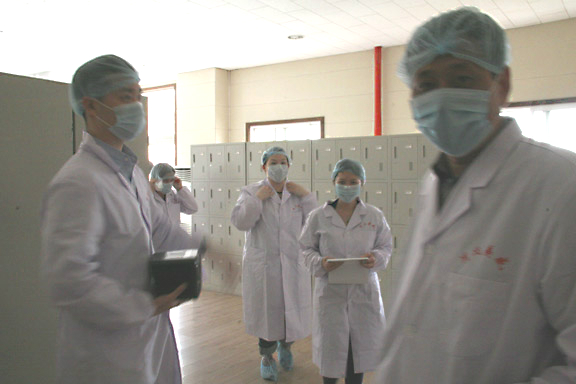
As an Herbal Consultant at Mayway, I have been speaking to customers for a long time about our Mayway Hebei facility. In April the Mayway Hebei facility in Anguo opened its doors for tours for the first time and I was fortunate to be among the Mayway US staff that led the tour. My first impression as I walked into the lobby of the Hebei facility was that it was a cool and clean respite from the haze and dust of the surrounding countryside and city. The following observations come from two tours of the processing facility, first with the other Mayway US staff in preparation for the 2011 Anguo Tour and then again during the tour proper.
It is evident that quality assurance starts even at the doorstep. To enter, one must step over a small knee-high barrier. This “rodent gate” provides a barrier to both critters and dust that is blowing across the ground. It also serves as an indicator that you have entered an area that is cleaner than the outside and serves as a mental reminder to slow down and pay attention to the process of changing into your clean gear. This was the first of many times that I would be putting on clothing to reduce outside contamination in the herb processing areas.
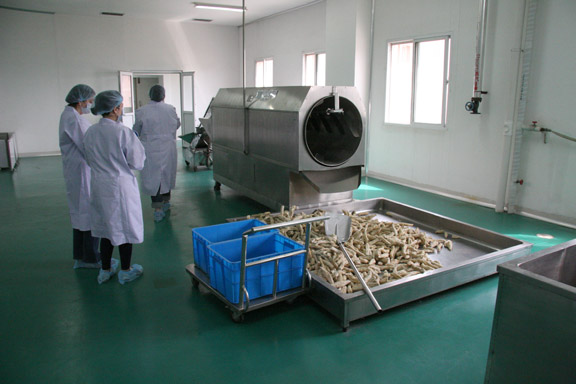
Workers have special blue uniforms that never leave the clean area, hats, disposable face masks, long sleeve coats, pants and shoes. For guests like ourselves or staff that is only entering for a short time the uniform we would don many times included disposable hair nets and face masks, knee length lab coats, and shoe covers. After a demonstration we all put on our “clean garb” and washed our hands thoroughly and then walked upstairs to the herb processing facility.
Throughout the entire process, each herb is processed according to protocols laid out in the Pharmacopoeia of the People’s Republic of China. When herbs first arrive at Hebei, they are received into the crude herb warehouse. Fresh from the farm, workers in this facility labor at preparing the herbs for later processing, knocking off loose soil, trimming rootlets and removing parts of the herb that are not used. Once this process has been completed herbs are moved to the herb processing warehouse.
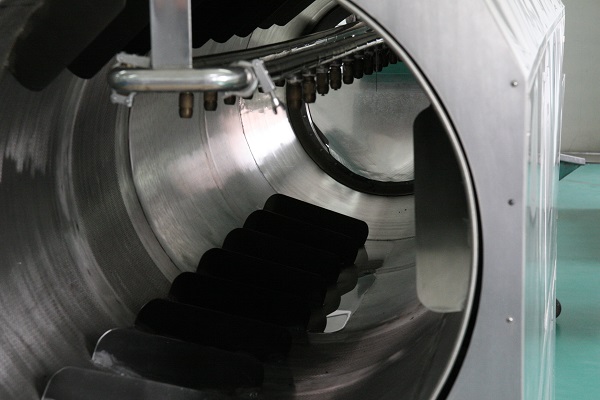
The first processing area we entered was a large room with blue green floors, spotless and brightly lit. During our tour a large batch of Shan Yao (Dioscorea opposita rhizome) was being washed. Herbs are soaked to remove recalcitrant dirt and then are shoveled into the spray washer that has two open ends. The inside of the washer looks like something akin to the inside of a cement mixer. As the drum of the washer spins, small fins push the herbs slowly past a series of spray jets. Once they reach the end, the herbs fall out onto a stainless steel tray where they can then be shoveled into bins to slowly air dry.
Some herbs are soaked after being washed to soften them for slicing; for some herbs this may take 1-2 days. There are some herbs that are hard to soften, softening them the usual way could take 15-20 days. In this case Hebei uses the “Herb Moistening Machine”. This is essentially a vacuum pressurized steam chamber. The vacuum allows for steam to be present at lower temperatures and avoids the loss of active ingredients during steaming. This process can shorten the softening time to 5-8 hours.
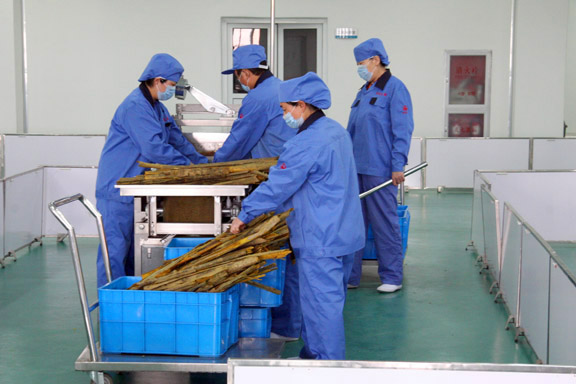
Grass-like or leafy herbs like Dan Zhu Ye (Lophatherum gracile herb) or Bo He (Mentha haplocalyx herb) do not require soaking or steaming as the washing process alone is enough to soften them prior to cutting.
Once they are ready, herbs are taken to one of a variety of slicing stations. Herbs like Sang Bai Pi (Morus alba root-bark) or Chen Pi (Citrus reticulata peel) are sliced on slicer with horizontal blade similar to a guillotine. Herbs are fed onto a short conveyer belt that pulls the herb toward the blade that moves slowly up and down. In the photo below, Huang Bai (Phellodendron amurense bark) is being sliced on this machine.
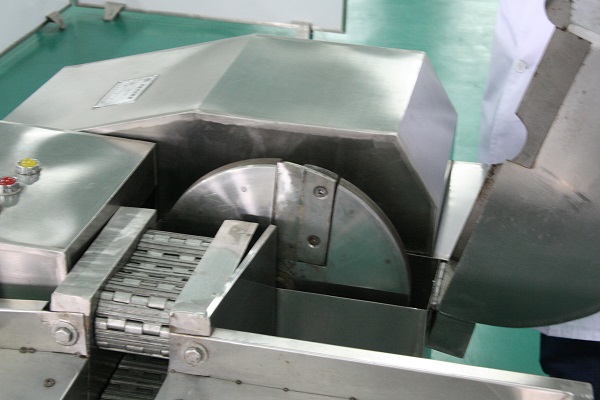
At another station using a spiral slicer, workers were slicing Shan Yao (Dioscorea opposita rhizome). In the photo you can see the small channel that holds the roots in place as they are fed through the slicer.
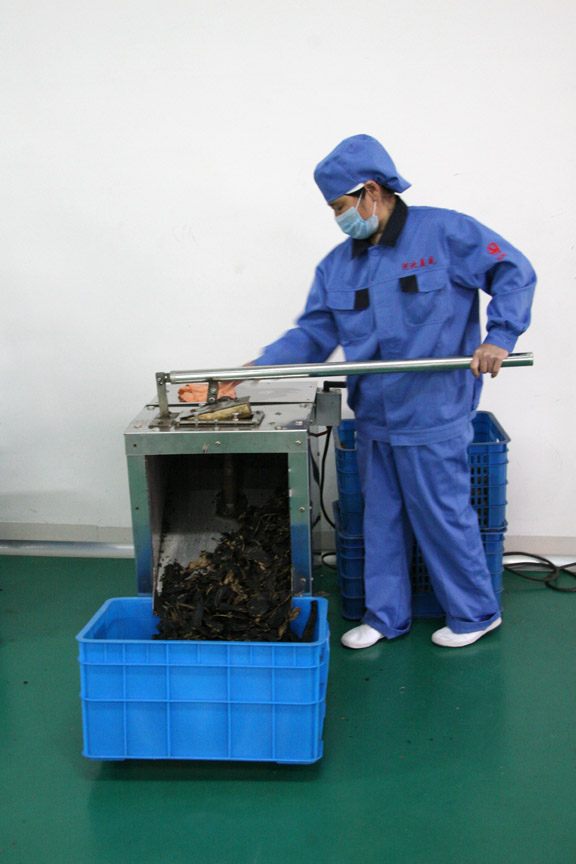
To the left, a worker is slicing Xuan Shen (Scrophularia ningpoensis root) on a machine that both flattens and slices herbs at the same time.
I think all of us were awestruck by the workers processing Jie Geng (Platycodon grandiflorum root). This particular herb is best sliced by hand. Here, workers take a single root and place it beneath a loop of steel that holds it to the cutting surface. This loop can be raised by a pedal. It was quite stunning to see the speed and precision of these workers as they sliced the Jie Geng.
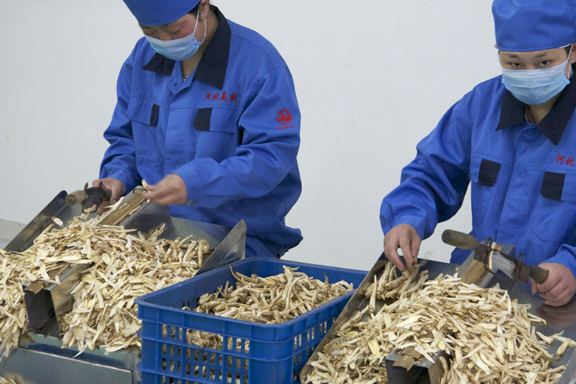
All of the workers in the processing facility know how to work at every station in the building. This helps to cut down on worker fatigue and repetitive injury but also means that during the busy season, workers can work at whatever station they are most needed.
From the washing and slicing room, herbs are moved to the drying area. Sliced and cut herbs are placed on a large conveyer belt that draws the herbs into the dryer that uses a combination of radiant heat and hot air convection to dry the herbs. They opened the dryer for us so that we could see the herbs moving through over a series of 6 conveyer belts from top to bottom. The temperature inside the dryer can vary but is generally around 140 degrees Fahrenheit. Each herb has a different drying time and the speed of the belts can be adjusted to accommodate the varying needs.
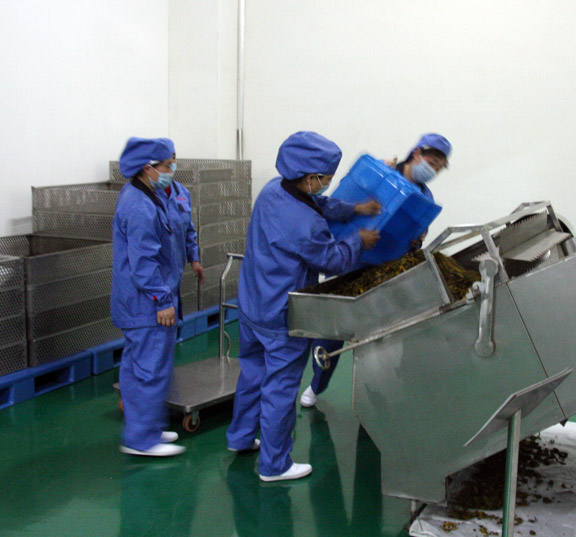
For certain herbs where it is known they have a naturally high microbial count, they can be put into a super-heated chamber that uses a combination of forced air, electric heat and steam heat to lower microbial levels. In the drying area, there is also a chamber for delicate herbs like grasses, leaves and flowers. These herbs would be damaged or blown away in the forced air dryer so they have a special chamber where these herbs are placed on racks for set period of time to dry out.
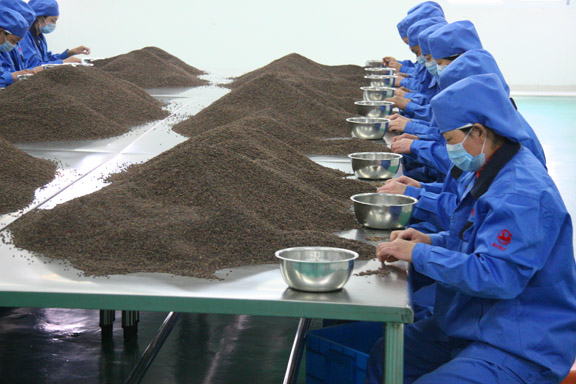
After being dried, some of the herbs must be taken for further processing, this includes but isn’t limited to steaming, calcining, dry-frying, honey-frying and processing with black bean juice.
Next we were taken down the hall past the machine sorting room to the hand sorting area. Here workers can pick out impurities like small stones and twigs, as well as remove any unsuitable herbs. On this day, workers were sorting Nu Zhen Zi (Ligustrum lucidum fruit) by hand. Larger herbs can be passed through a machine that uses air to separate the herbs from organic debris. Herbs like Nu Zhen Zi (see image below) or Bai Zi Ren (Biota orientalis seed) would get blown away so they need to sort them by hand. It was truly amazing to see how much manual labor goes into every bag of herbs.
Before we were taken downstairs to the packaging area we got to see a room where they package herbs for distribution to various hospitals within China. In the image below, they are weighing out and packing 10 gram packets of Dang Gui (Angelica sinensis root) for an area hospital.
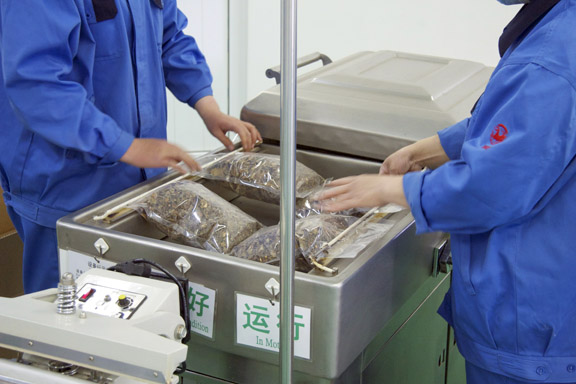
Next we were taken downstairs to see Plum Flower ® herbs being weighed, vacuum packed and sealed. Herbs are weighed and bagged around a central table and then taken to the vacuum sealing station.
Plum Flower® herbs have two bags, the inner bag is vacuum sealed and then these bags are placed inside the outer bag that has the label on it. This outer bag is placed on another machine that both removes the regular air from between the two bags and injects nitrogen gas between them and then seals the bag. This inert gas provides two functions; it helps to reduce oxidation of the herbs and also cushions the herbs to protect them during transport. This packaging combined with the various drying methods is part of the process that enables Plum Flower® herbs to be delivered without the use of preservatives.
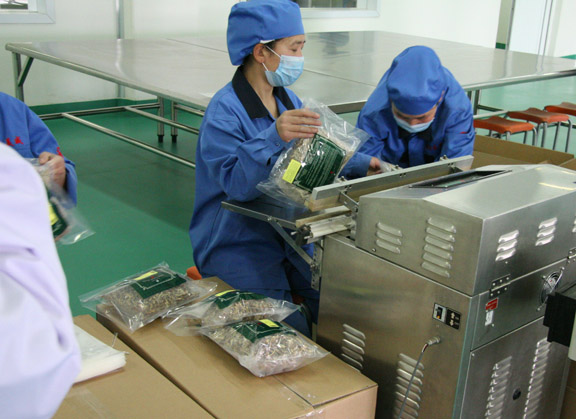
After the outer bags are sealed, they are placed in boxes and taken to special palettes in the finished product warehouse where they are held until there are enough boxes to fill a shipping container.
As a licensed acupuncturist I feel very fortunate to have been able to see how the herbs we use make it from the fields into my clinic. As an herbal consultant for Mayway I am happy that I now have in depth and first-hand experience about how Plum Flower ® herbs in particular are processed, but more than anything I feel grateful for the opportunity to meet the staff at Mayway Hebei, and see with my own eyes the quality, dedication and heart that goes into their labor.
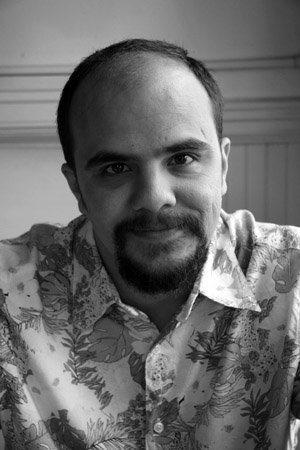 Bio: Teo Potts, L.Ac. has worked for Mayway Corporation as an Herbal Consultant since 2006. In this capacity he regularly assists acupuncturists, physicians, chiropractors and veterinarians from around the country with the selection of herbal formulas for their patients. Teo has a private practice in Emeryville, California, where he combines Chinese herbal medicine, acupuncture and massage. He specializes in pediatrics, pain, and dermatological conditions.
Bio: Teo Potts, L.Ac. has worked for Mayway Corporation as an Herbal Consultant since 2006. In this capacity he regularly assists acupuncturists, physicians, chiropractors and veterinarians from around the country with the selection of herbal formulas for their patients. Teo has a private practice in Emeryville, California, where he combines Chinese herbal medicine, acupuncture and massage. He specializes in pediatrics, pain, and dermatological conditions.

